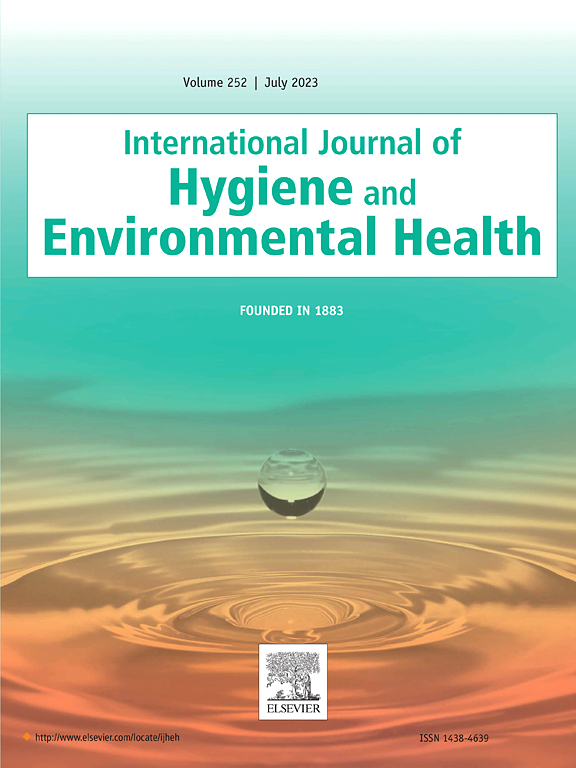Standardised protocol for the detection and quantification of nontuberculous mycobacteria (NTM) in tap water and its application in investigating the source of NTM clinical infections
IF 4.4
2区 医学
Q1 INFECTIOUS DISEASES
International journal of hygiene and environmental health
Pub Date : 2025-07-01
DOI:10.1016/j.ijheh.2025.114618
引用次数: 0
Abstract
Nontuberculous mycobacteria (NTM) are emerging pathogens causing pulmonary and extrapulmonary diseases, including healthcare-related infections. Although water is one of the main infection sources, isolating NTM from water samples is rarely done due to the NTM fastidious growth and lack of a standardised method. We propose a standardised NTM detection protocol from tap water. We set a protocol for NTM cultivation, measured its repeatability (n = 20 experiments, 5 for each condition), reproducibility (n = 20, 5 for each condition), and performed an inter-laboratory comparison (n = 6) using sterile and tap water samples spiked with slowly growing (M. avium) and rapidly growing (M. chelonae) NTM, plus artificial contamination (Pseudomonas aeruginosa). We investigated water-related NTM infections using this protocol from 2014 to 2024. The protocol showed good repeatability, reproducibility, and recovery yield (range: 67–131 %) for quantifying NTM in artificial samples. The inter-laboratory agreement was 83 %. It was consistent with different growth media and temperatures. The addition of P. aeruginosa did not affect NTM recovery. We used the protocol in 12 investigations, involving 24 patients. NTM were detected in 11/12 investigations (92 %, 23 patients) with species being the same as patients’ isolates in 6/11 (55 %, 18 patients). Water was identified as a source of infection in 5/12 (42 %) investigations involving 15/24 patients (62 %) based on matching genotypes. This study provides a protocol for detecting and quantifying NTM colonies in tap water, which allows identifying the source of clinical infections. With an increase in NTM infections, using this method in mycobacteriology and in environmental laboratories could be beneficial.
自来水中非结核分枝杆菌(NTM)检测与定量标准化方案及其在NTM临床感染源调查中的应用
非结核分枝杆菌(NTM)是引起肺部和肺外疾病的新兴病原体,包括卫生保健相关感染。虽然水是主要感染源之一,但由于NTM的生长挑剔和缺乏标准化方法,很少从水样中分离NTM。我们提出了一种标准化的自来水NTM检测方案。我们制定了NTM培养方案,测量了其重复性(n = 20次实验,每种条件下5次)和重现性(n = 20次,每种条件下5次),并使用无菌和自来水样品进行了实验室间比较(n = 6),其中添加了缓慢生长的(鸟芽胞杆菌)和快速生长的(chelonae) NTM,以及人工污染(铜绿假单胞菌)。2014年至2024年,我们使用该方案调查了与水相关的NTM感染。该方法对人工样品中NTM的定量具有良好的重复性、再现性和回收率(范围:67 ~ 131%)。实验室间的一致性为83%。在不同的生长介质和温度下,结果一致。铜绿假单胞菌的添加不影响NTM的恢复。我们在12项研究中使用了该方案,涉及24名患者。在11/12例(92%,23例)调查中检出NTM, 6/11例(55%,18例)调查中检出与患者分离的菌株相同。根据匹配的基因型,在涉及15/24例患者(62%)的5/12(42%)调查中,水被确定为感染源。本研究为自来水中NTM菌落的检测和定量提供了一种方案,从而可以确定临床感染的来源。随着NTM感染的增加,在分枝杆菌学和环境实验室中使用这种方法可能是有益的。
本文章由计算机程序翻译,如有差异,请以英文原文为准。
求助全文
约1分钟内获得全文
求助全文
来源期刊
CiteScore
11.50
自引率
5.00%
发文量
151
审稿时长
22 days
期刊介绍:
The International Journal of Hygiene and Environmental Health serves as a multidisciplinary forum for original reports on exposure assessment and the reactions to and consequences of human exposure to the biological, chemical, and physical environment. Research reports, short communications, reviews, scientific comments, technical notes, and editorials will be peer-reviewed before acceptance for publication. Priority will be given to articles on epidemiological aspects of environmental toxicology, health risk assessments, susceptible (sub) populations, sanitation and clean water, human biomonitoring, environmental medicine, and public health aspects of exposure-related outcomes.

 求助内容:
求助内容: 应助结果提醒方式:
应助结果提醒方式:


